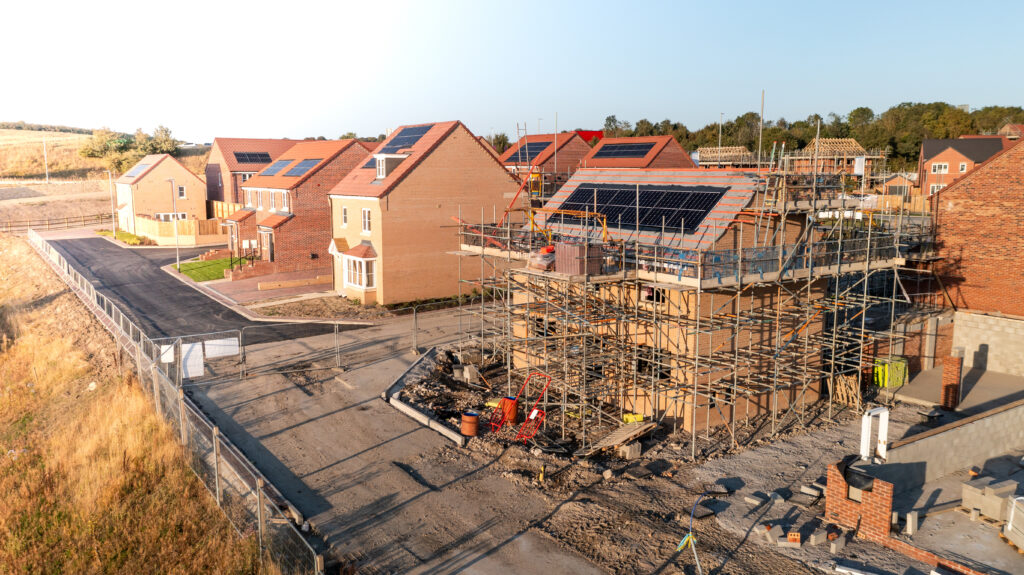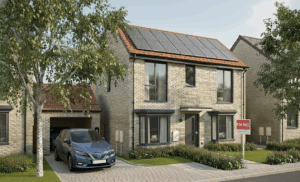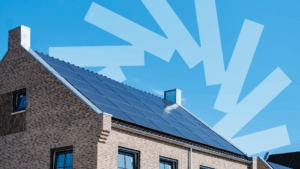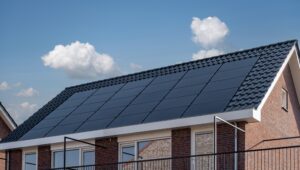As the government moves closer to implementing the Future Homes Standard, housebuilders across the country must prepare for a major shift: mandatory solar panels in new homes from 2027.
Rooftop solar will now be an essential tool for housebuilders to meet decarbonisation targets and deliver the homes that today’s home buyers want. But with new compliance pressures comes concern around cost, particularly at scale. That’s why many developers are now exploring alternative delivery models, such as fully funded solar leasing, which can help integrate solar without the upfront capital burden. These approaches allow housebuilders to meet emerging requirements while keeping commercial viability intact.
Below we unpack what the forthcoming legislation means, what’s still being clarified, and how housebuilders can proactively adapt to meet regulatory compliance and exceed homebuyer expectations while maintaining their margins.
What’s Changing with the Future Homes Standard?
The Future Homes Standard, set to come into force in 2025, is part of the UK government’s broader net zero strategy. It mandates that all new homes must produce 75–80% less carbon emissions compared to the benchmark levels. A key component of achieving this target will be mandatory solar panel installations on all new residential builds.
Although the full technical details are still to be released, the government has announced that housebuilders will be legally required to install solar panels on the roofs of most new properties by 2027.
If you have projects currently in the design or planning stage, factoring in solar is essential. Exploring fully-funded models like Gryd’s can help you align with the new regulations while keeping margins intact and avoiding disruption to build schedules.
Understanding the Costs
For housebuilders unfamiliar with solar systems, cost planning is a common concern. The good news is that solar technology has become significantly cheaper and more efficient in the past decade. However, the pressure to deliver low-carbon homes at scale is causing many housebuilders to install the minimum viable solar systems to meet current building regulations.
The average size of home solar systems being installed has decreased from about 4kWp in 2023 to 2.4kWp in 2024. A 2.4kWp system is inadequate for even modest energy needs and leaves no headroom for future demands, such as electric vehicle charging, electric heating, or growing families. Installing a larger 5–6kW system offers a far more futureproof solution and delivers greater long-term savings and carbon reduction.
Importantly at any size profile, every solar system should include battery storage to maximise the system’s efficiency and enable true energy independence, today and in the future.
Below we break down the typical costs of various solar system sizes, with and without battery storage:
| System Size | No. of Panels | Solar Only (Installed Cost) | Solar + Battery (Installed Cost) |
| 3 kW | 7–8 panels | £4,500 – £5,500 | £7,000 – £8,500 |
| 4 kW | 9–11 panels | £5,500 – £6,500 | £8,000 – £9,500 |
| 5 kW | 12–13 panels | £6,500 – £7,500 | £10,000 – £12,000 |
| 6 kW | 14–16 panels | £7,000 – £8,500 | £11,000 – £13,500 |
These range estimates reflect the typical cost of solar panels, inverter, installation, and basic equipment. While batteries are optional, they are increasingly seen as essential for future-proofing a home solar system – unlocking its full potential and allowing homeowners to store excess energy for use at night or when the sun isn’t shining as strongly.
Preparing for the Future Homes Standard and Beyond
Solar is no longer just an environmental choice; it’s a financial one. Recent surveys show that a majority of today’s home buyers want lower energy bills, long-term energy security, and homes that are truly built for the future, not just for compliance.
Developers who get ahead of the regulatory curve and respond to the consumer demand that is already robust in the market have the chance to gain the competitive edge.
If you’re looking to add the benefits of rooftop solar onto your developments without the financial burden of purchasing and ownership, Gryd’s fully-funded model is a great option. Our smart solar systems offer a turnkey solution to the forthcoming mandate with no capital investment or system ownership required.
Your homes will come with futureproofed smart solar and battery systems built-in and optimised for each property, allowing homebuyers to benefit from lower bills and greener energy from day one.
Ready to get ahead of the solar mandate?
We work directly with developers to streamline deployment across entire projects, from specification to completion. For developers exploring the most efficient path to compliance, Gryd’s fully-funded solar model can reduce financial strain while keeping projects on track.
Contact Gryd today to discuss how solar can be integrated into your upcoming developments affordably and with future compliance standards in mind. Let’s build the homes of the future, today.



